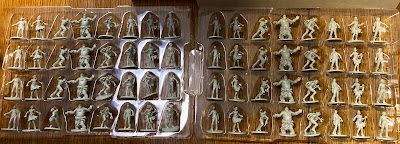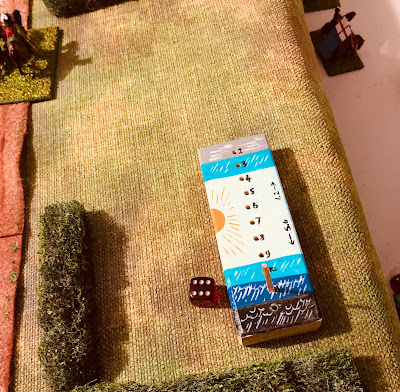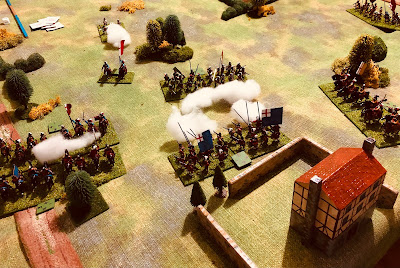The game and tabletop setup uses the ideas from the "The Battle of Langensalza", chapter 15 in "Wargame Tactics" by Charles Grant. The original setting was for the Seven Years War, but has been repurposed for the War of the Spanish Succession and also scaled down by half as I have no where near the number of figures described in the chapter.
For the rules I am using the WSS Card home-brew rules mentioned in my previous post, and also found on the blog's header.
Order of battle
France:
- 2 x Cavalry
- 3 x Infantry
- 2 x Dragoons
- 1 x Artillery
- 1 x Mortar
Alliance:
- 3 x Cavalry
- 4 x Infantry
- 1 x Artillery
Both sides fielded 3 Commanders and 1 General which are used in the game to rally and reorganise units.
The objectives for both armies are to capture and control the town near an important river crossing.
 |
| Deployment of forces. French are depicted in blue and the Alliance in red. The French dragoons can arrive through the woods on their left flank. |
 |
| A view of the tabletop from behind the Alliance forces. All units are Paper Soldiers standing at 42mm tall because I increase the size when printing. I do this so I can see the art work better and they are less fiddly to cut out. |
 |
| French dragoons arrive through the woods. |
The opening turns had both sides pushing forward. On their right flank the Alliance stopped and deployed in the hill. The French were able to occupy the town first, as the Alliance were mostly deployed and moved at a slower pace. The French dragoons soon appeared on the flank from the woods.
 |
| A general advance by both sides for the opening move. |
 |
| The French dragoons appear from the woods, while artillery from both sides exchange shots. |
 |
| A large cavalry engagement occurs on the other flank. |
The cavalry engagement was a hard fought affair, and with two evenly matched cavalry forces it was going to be touch and go as to who would win. Both sides used their available commanders to rally troops. In the end the Alliance managed to gain the upper hand.
 |
The Alliance cavalry gain the upper hand in a hard fought engagement. Whoever won the engagement would be pretty much nullified as a threat and unable to withstand any serious opposition.
|
 |
| Movement of forces on the battlefield. |
The French Dragoons arrived but had not progressed as far through the woods as they expected, and were less of a surprise and easily countered. While they swiftly attacked it was unlikely to be more than a diversion. Even more so when the Alliance reserve cavalry unit arrived.
 |
| The dragoons put up a spirited attack, but failure was always on the cards (excuse the pun) |
In the centre the French still had some reasonably fresh units, but the threat of cavalry appearing on the flank, and lacking any more reserves, meant they had been reluctant to fully support the town's defence. Eventually, the town changed hands and was occupied by the Alliance.
 |
| The Alliance gain access to the town |
 |
| With a flank exposed, even to a very weak cavalry force, the French line is obliged to retire. |
A victory to the Alliance who by securing the river flank where able to do just enough to gain control of the town. The French dragoons who were intended to be the main threat appeared too early from the woods and were easily countered. Had they appeared later and further towards the Allied rear the story could have been different.
How did the rules play?
There was not a lot of difference from using cards (red/blank) rather than D3 dice (1,1,2,2,3,3) for combat. The slight difference was for the winning unit, which in most cases would not stand up to more than one attack before being routed. Now I quite like this as I am always troubled by units going on to make too much mischief after an engagement, unless they are rallied and reorganised by a commander.











































